Transforming your living space into a lush oasis of greenery and elegance is easy with tall indoor plants. These botanical giants not only add a touch of natural beauty but also contribute to a healthier indoor environment. Whether you have a spacious living room, a cozy corner, or a sunlit office, there’s a perfect tall indoor plant to match your room and lifestyle. Discover twenty-five beautiful tall indoor plants, each with its unique charm and benefits, ready to breathe life into any room, no matter the size or style. Say goodbye to empty corners and hello to a greener, more vibrant home.
1. African Milk Tree (Euphorbia trigona)
The African milk tree, or cathedral cactus, is a striking succulent plant native to Western Africa, particularly Nigeria. Despite its name, it is not a true cactus but belongs to the Euphorbia genus. This distinctive and eye-catching plant has earned its place as a favorite among indoor plant enthusiasts for its unique appearance and ease of care.
The tall houseplant has a dramatic and architectural presence. It features upright, columnar stems that can reach up to 6 to 8 feet indoors. The stems are typically three-angled, forming a triangular shape along their length. Additionally, each stem is lined with sharp, sturdy spines that give the plant a distinctive appearance. The stems are typically green, but they can develop a reddish tint under certain lighting conditions, adding to their allure.
The African milk tree is a low-maintenance indoor plant, making it an excellent choice for both novice and experienced plant enthusiasts. It thrives in bright, indirect sunlight. Place it near a sunny window, but protect it from intense, direct sunlight, which can scorch its stems. This succulent prefers warm temperatures between 65 to 75 degrees Fahrenheit. However, it can tolerate slightly cooler conditions but should be protected from frost.
Allow the soil to dry out completely between waterings. Overwatering can lead to root rot, so it’s best to err on the side of underwatering. Furthermore, use a well-draining cactus or succulent potting mix to ensure proper drainage. Prune the plant sparingly to remove any dead or damaged stems, and be cautious when handling it due to its sharp spines.
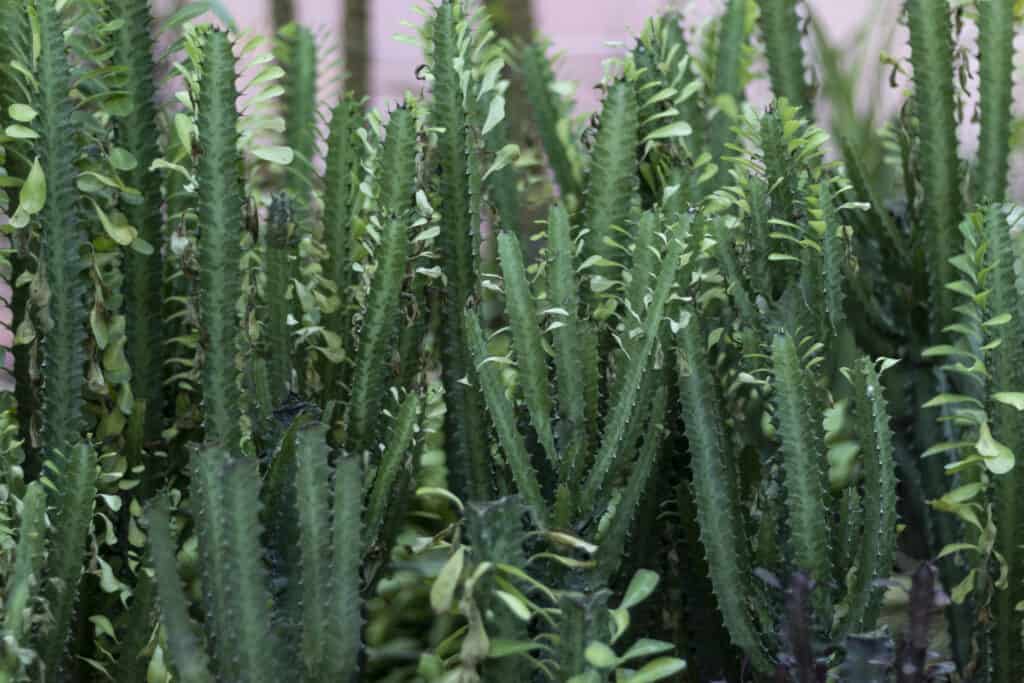
The African milk tree is incredibly long-living.
©iStock.com/Bilal photos
2. Areca Palm (Dypsis lutescens)
The areca palm is a popular indoor plant cherished for its graceful appearance and air-purifying qualities. Native to Madagascar, this palm species’ lush fronds and easygoing nature make them a splendid addition to any indoor space. The areca palm produces feathery, arching fronds that resemble the shape of a fishtail, giving it the nickname “Butterfly Palm.
When well-cared for, it can grow up to 6 to 7 feet indoors. Its slender, green stems are topped with vibrant, pinnate leaves that create a lush, tropical canopy. As it matures, it forms multiple trunks, enhancing its visual appeal.
Areca Palms are relatively easy to care for, making them an excellent choice for indoor gardening. These slow-growing palms thrive in bright, indirect sunlight. Place them near a window with filtered light, but avoid exposing them to direct sunlight, which can scorch their leaves.
They are sensitive to cold drafts and prefer temperatures between 65 to 75 degrees Fahrenheit. Additionally, protect them from sudden temperature drops. Keep the soil consistently moist but not waterlogged. Allow the top inch of soil to dry out between waterings, and adjust your watering frequency based on your indoor humidity and lighting conditions.
Areca Palms appreciate higher humidity levels. Mist the foliage regularly or use a humidity tray to maintain adequate moisture. Furthermore, use a well-draining potting mix to ensure proper drainage. Trim brown or yellowing fronds to maintain the plant’s appearance and overall health.
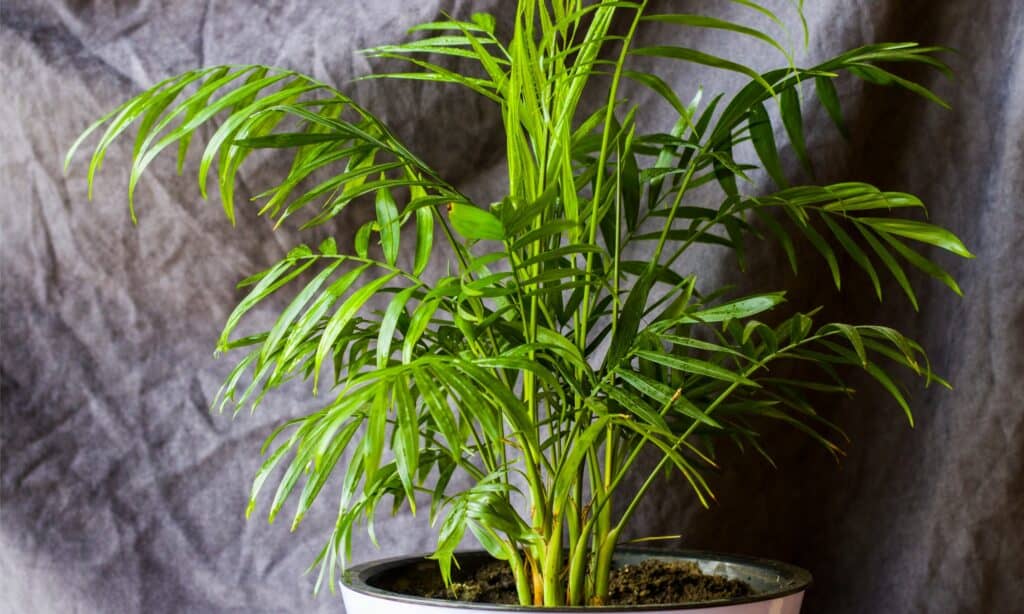
The areca palm is also known as the butterfly palm.
©iStock.com/Tamar Dundua
3. Australian Tree Fern (Sphaeropteris cooperi)
Ancient and alluring, the Australian tree fern brings a tropical vibe indoors. It is a prehistoric plant native to the rainforests of Australia and nearby regions. It produces large, deeply divided, and finely pinnate fronds, which create a lush and intricate canopy. Its fronds emerge from a central crown, and as they unfurl, they form a canopy that can reach up to 10 feet or more indoors. Additionally, its trunk is covered in a fibrous, woody material that gives it a unique texture.
The Australian tree fern is relatively high-maintenance and requires regular pruning to remove dead fronds and retain its appearance. It grows best in indirect light near windows. Furthermore, direct sunlight can scorch its fronds. Specimens also require high humidity levels.
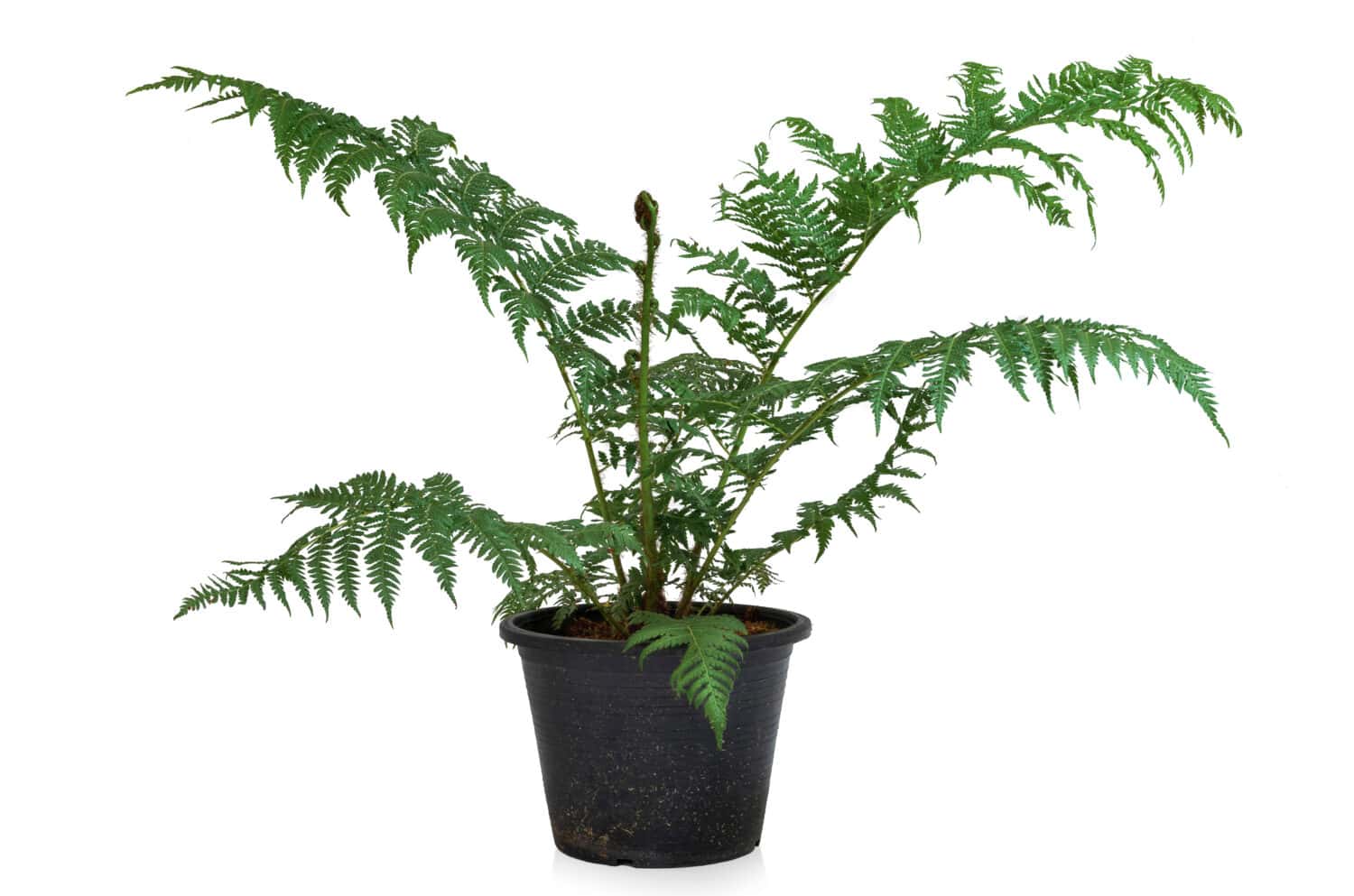
The Australian fern tree reaches up to 50 feet in the wild.
©Suprachai Akkho/Shutterstock.com
4. Bird of Paradise (Strelitzia reginae)
The bird of paradise is a botanical masterpiece renowned for its stunning foliage and resemblance to the vibrant plumes of a tropical bird in flight. Native to South Africa, this exotic plant has become a symbol of luxury and sophistication in indoor gardening.
The bird of paradise produces large, banana-like leaves with a brilliant, contrasting color palette along long, arching stems that reach 6 feet tall. The leaves are predominantly deep green with distinct rib-like veins and feature vibrant orange or yellow accents, resembling the plumage of a bird. When mature, the plant may also produce iconic, crane-shaped flowers that emerge from a boat-like bract.
While the bird of paradise requires some care, its striking appearance makes it worth the effort. These plants thrive in indirect sunlight. Place them near a sunny window, ensuring they receive several hours of filtered sunlight each day. Additionally, maintain a warm environment, ideally between 65 to 70 degrees Fahrenheit, and protect them from cold drafts.
The bird of paradise grows best in consistently moist soil, especially during the growing seasons in the spring and summer. However, allow the top inch of soil to dry out between waterings and reduce watering in the dormant winter months. Furthermore, bird of paradise plants appreciate higher humidity levels. Regularly mist the foliage or use a humidity tray to create the necessary moisture.
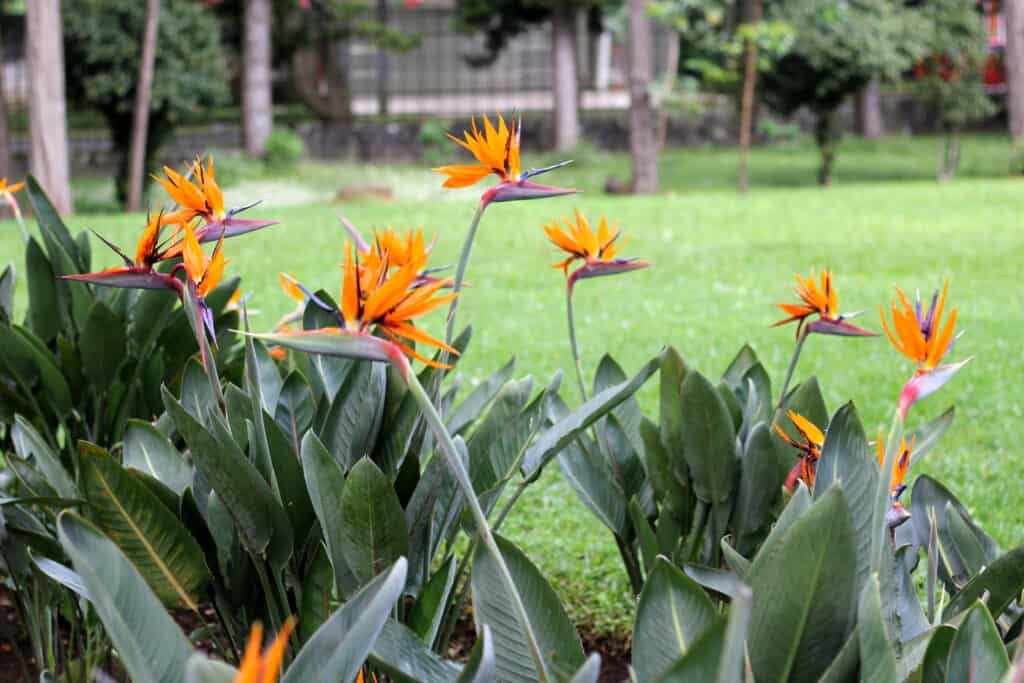
Bird of paradise is native to South Africa.
©iStock.com/Arlette Lopez
5. Cat Palm (Chamaedorea cataractarum)
Native to Mexico and Central America, the tropical cat palm has elegant foliage and an airy texture. Its graceful and arching fronds are feathery and pinnate, emerging from slender, bamboo-like stems. The fronds are typically bright green and have a delicate appearance, adding to the plant’s visual charm.
The cat palm grows to around 6 feet indoors, with a graceful and arching appearance. It is low-maintenance. However, it appreciates the occasional pruning to remove overgrown fronds. It grows best in indirect light and does not tolerate direct sunlight. It also does not tolerate waterlogged soil but appreciates consistent moisture. Specimens also love high humidity levels and appreciate regular misting.
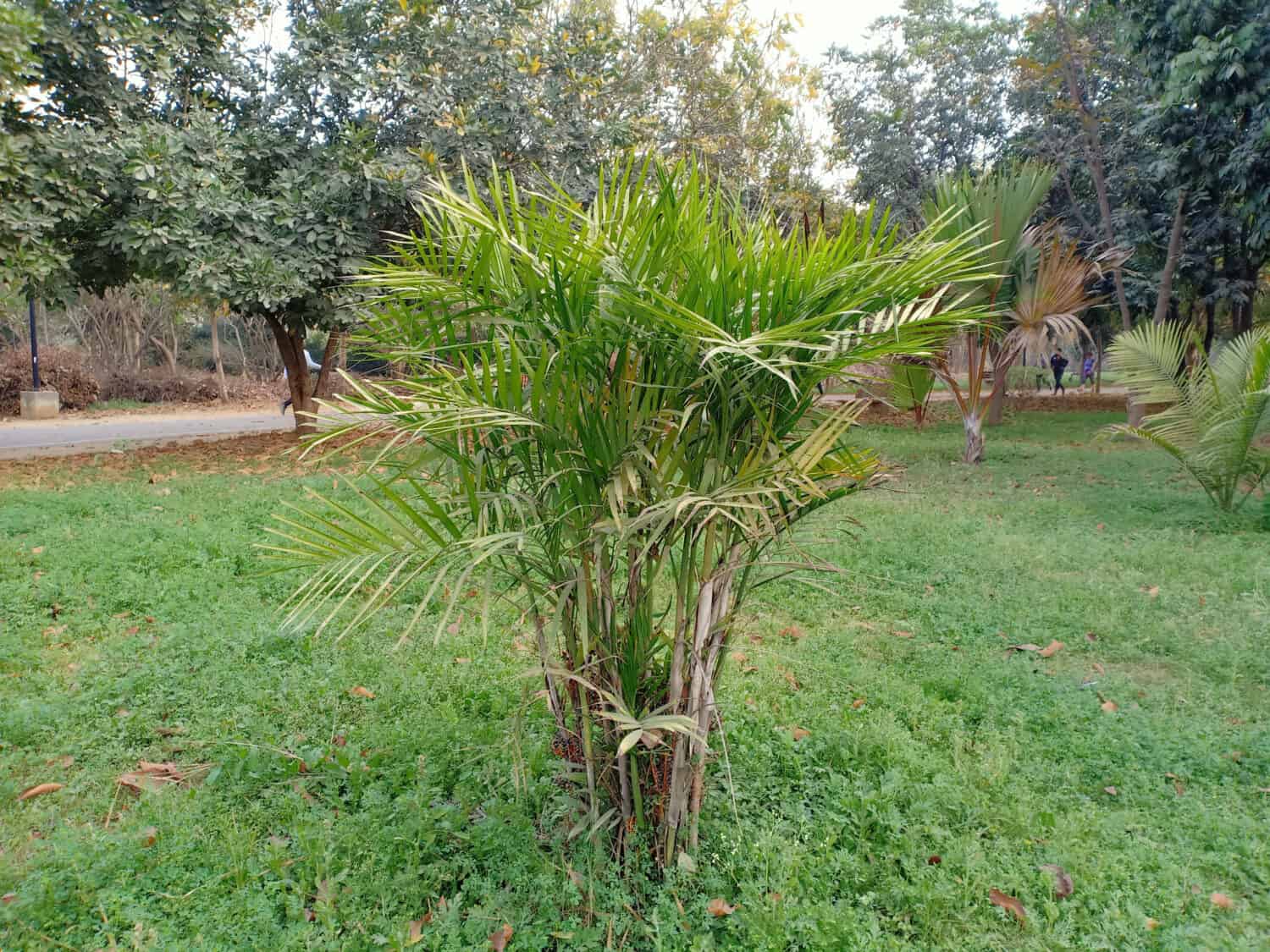
Cat palm is also known as cascade or cataract palm.
©Vipul1989/Shutterstock.com
6. Corn Plant (Dracaena fragrans)
Originating from tropical Africa, the corn plant is hardy and versatile, and its graceful foliage and low-maintenance nature make it an excellent addition to any indoor space. It produces arching leaves that resemble the shape of cornstalks. Its sturdy stems, which can be cane-like in appearance, are often marked with decorative patterns.
When grown indoors, corn plants can reach up to 6 feet or more, creating a vertical presence that adds depth to your interior decor. The leaves are typically deep green, but there are variegated varieties with stripes of lighter green or white. These plants thrive in moderate to low light conditions, making them ideal for spaces with limited natural light. Additionally, avoid direct sunlight, which can scorch the leaves.
Protect specimens from cold drafts and allow the top inch or two of soil to dry out between waterings. Corn plants are susceptible to root rot if overwatered, so it’s best to water sparingly. They can also adapt to various humidity levels but appreciate occasional misting or placement near a humidity source in dry indoor environments.

comes from the Greek word meaning female dragon.
©Sachiczko/Shutterstock.com
7. Croton (Codiaeum variegatum)
This remarkable indoor plant produces vivid and multicolored foliage. Originating from the tropical regions of Southeast Asia and the Pacific Islands, the croton adds a burst of color and tropical charm. It has bold and artistic leaves, which come in a wide array of colors and patterns.
Furthermore, its leaves are typically glossy and feature vibrant combinations of red, orange, yellow, green, and even purple. Depending on the variety, the leaves can be broad or slender, but they always make a bold statement. Croton plants generally grow to 6 feet when cultivated indoors, creating a striking vertical presence.
Croton plants thrive in bright, indirect sunlight. Place them near a sunny window where they can receive ample but filtered light. Adequate light is crucial for maintaining their vibrant leaf colors. Additionally, keep your croton in a warm environment and protect it from drafts and sudden temperature drops.
Maintain evenly moist but not waterlogged soil, allowing the top inch of the soil to dry out between waterings, but avoid letting it dry completely. Croton plants also appreciate higher humidity levels. Regularly mist the foliage or use a humidity tray to create the necessary moisture. Trim leggy or overgrown stems to maintain the plant’s shape and encourage bushier growth.
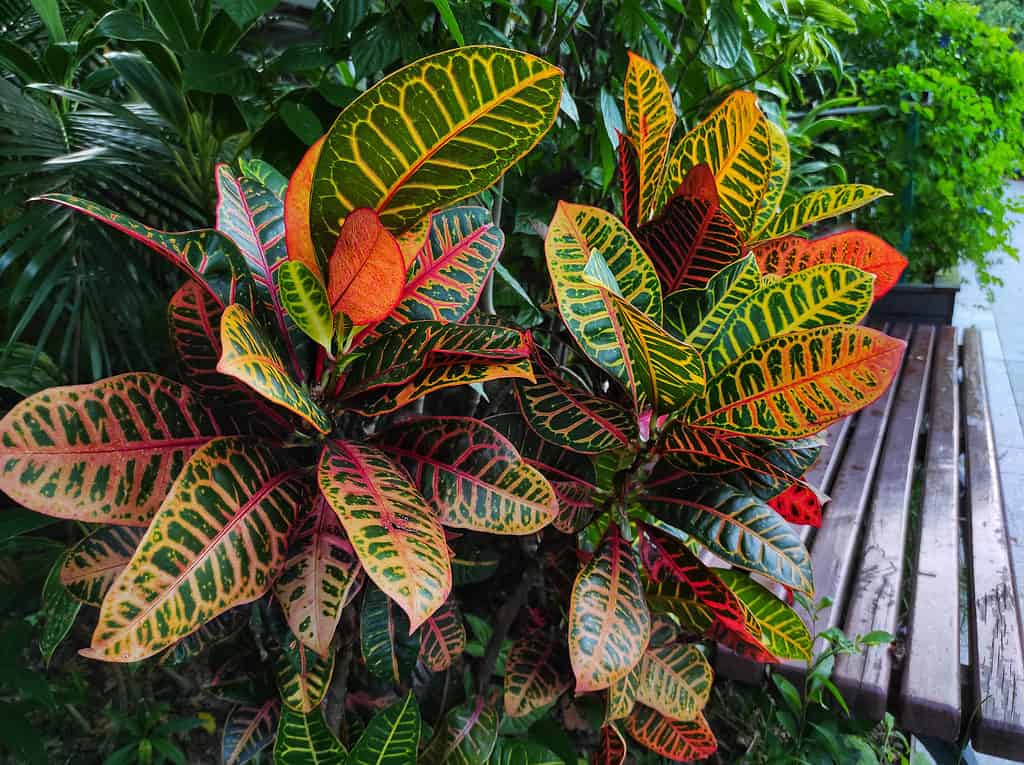
Croton sap can irritate the skin.
©iStock.com/Hanna Yohanna
8. False Banana Tree (Ensete ventricosum)
The false banana tree’s tropical allure and distinctive fruit make it an intriguing choice for those looking to introduce a touch of exotic beauty into their indoor spaces. Specimens produce lush foliage and unique, inedible fruits. They are native to East Africa, particularly Ethiopia. Additionally, the false banana tree is closely related to true banana plants.
The plant produces large, paddle-shaped leaves that create a dramatic and tropical canopy. These leaves are typically deep green and have a glossy appearance. Unlike true banana plants, which produce edible fruit, the false banana tree’s fruit is inedible and not typically grown for consumption.
Specimens don’t grow over 10 feet indoors. However, they can reach an impressive 20 feet in the wild. The tropical plant is relatively high-maintenance and requires regular pruning and trimming to maintain its appearance. It grows best in indirect light and does not tolerate direct sunlight. It is also intolerant of drafts and waterlogged soil.
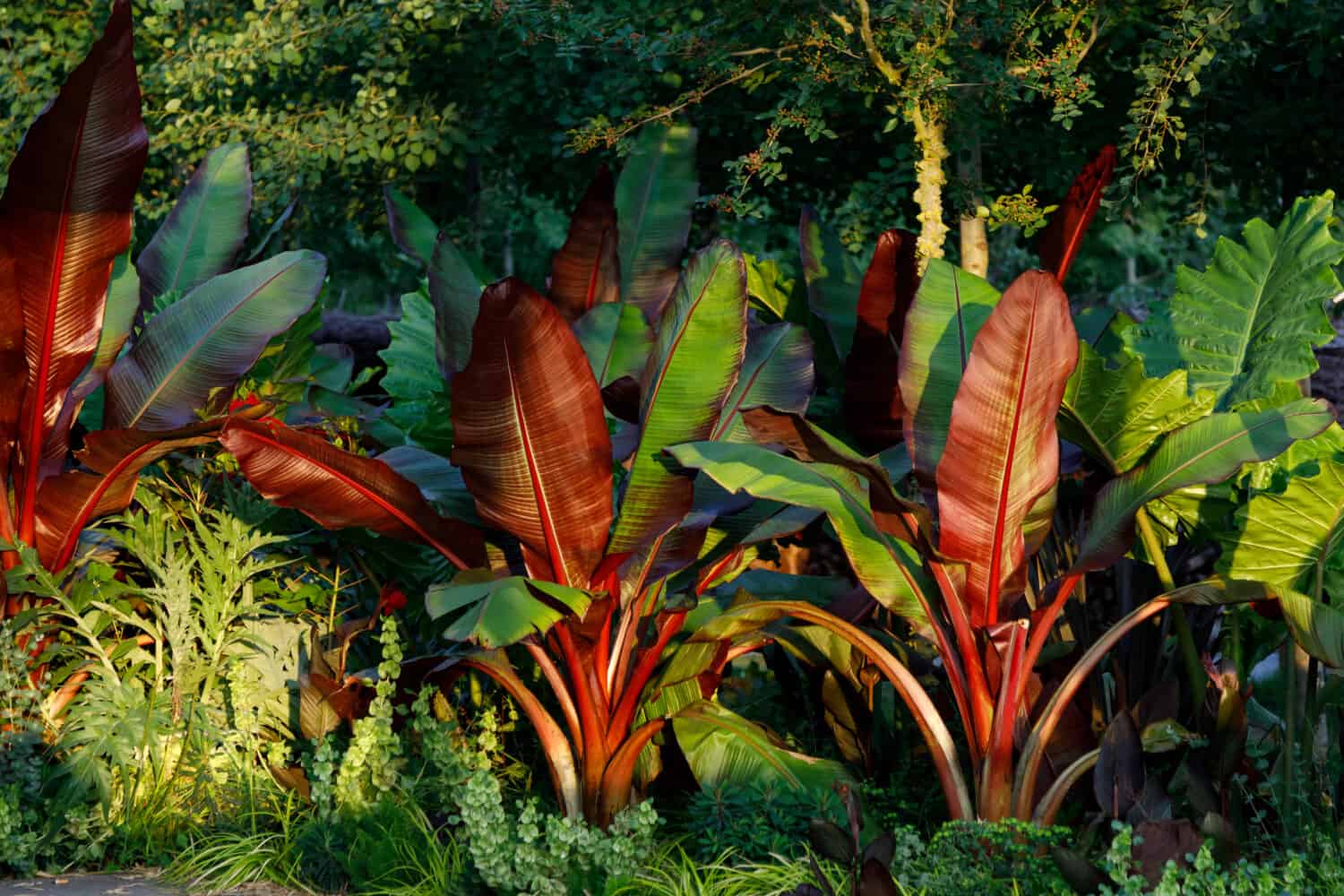
False banana tree is Ethiopia’s most important root crop.
©LariBat/Shutterstock.com
9. Fiddle Leaf Fig (Ficus lyrata)
Perhaps one of the most iconic houseplants in existence, the fiddle leaf fig, or Ficus, originates from the rainforests of West Africa. It has gained immense popularity among interior decorators and plant enthusiasts thanks to its striking foliage and air-purifying qualities. The fiddle leaf fig produces large, glossy, violin-shaped leaves, which can grow up to 12 inches wide and 15 inches long. These impressive leaves are rich green and have prominent veins, giving the plant a tropical and luxurious appearance.
When cultivated indoors, fiddle leaf fig grows up to 10 feet or more, making it a true statement piece in your home. These plants thrive in bright, indirect sunlight. Place them near a window with filtered light, ensuring they receive plenty of illumination without direct sun exposure.
Additionally, maintain a warm environment and avoid sudden temperature fluctuations. Keep the soil consistently moist but not waterlogged, and water sparingly during the dormant winter months. Fiddle leaf figs also appreciate higher humidity levels and regular misting.

Mist fiddle leaf fig to remove dust and increase humidity levels.
©AngieYeoh/Shutterstock.com
10. Fishtail Palm (Caryota)
Create a tropical escape with the fishtail palm. Native to Southeast Asia and the South Pacific, this remarkable palm species produces distinctive foliage and has a graceful appearance. It has bipinnate fronds that resemble the tail of a fish. Additionally, its fronds are typically large, lush, and deeply divided, creating an intricate and visually captivating canopy.
The fishtail palm grows up to 10 feet indoors. It does not tolerate direct sunlight and grows best in filtered light near a window. It is also sensitive to cold drafts and temperature fluctuation and thrives in warm environments. Fishtail palms love moist but never waterlogged soil. They also require high humidity and appreciate regular misting. The high-maintenance species respond well to pruning and trimming to maintain its shape.
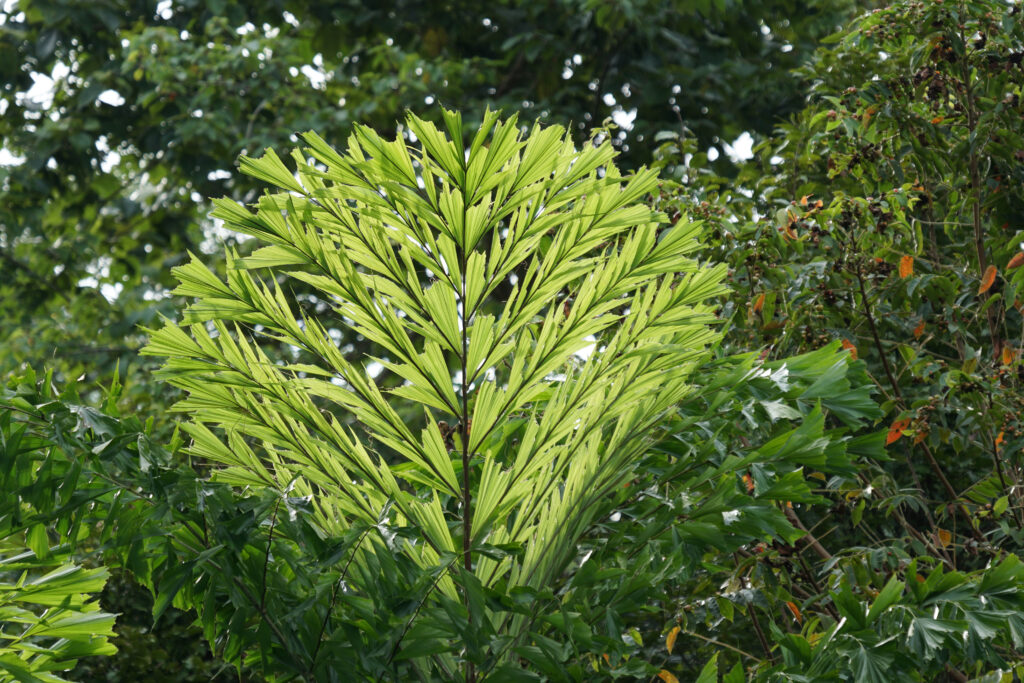
Fishtail palm is a common solitary palm variety.
©Doikanoy/Shutterstock.com
11. Hawaiian Ti (Cordyline fruticosa)
You can also escape to the tropics with the Hawaiian ti plant. It is a vibrant and eye-catching indoor plant with colorful foliage and tropical allure. Native to Southeast Asia and the Pacific Islands, it produces large, lance-shaped leaves that come in an array of hues, including green, red, pink, and variegated combinations. The leaves can have a glossy or matte finish, depending on the variety.
The Hawaiian ti plant reaches up to 6 feet indoors and is low-maintenance. It appreciates high humidity levels and requires regular misting. Specimens grow best in indirect light and require consistent moisture. However, avoid water logging the Hawaiian ti plant and protect it from extreme temperature fluctuations.
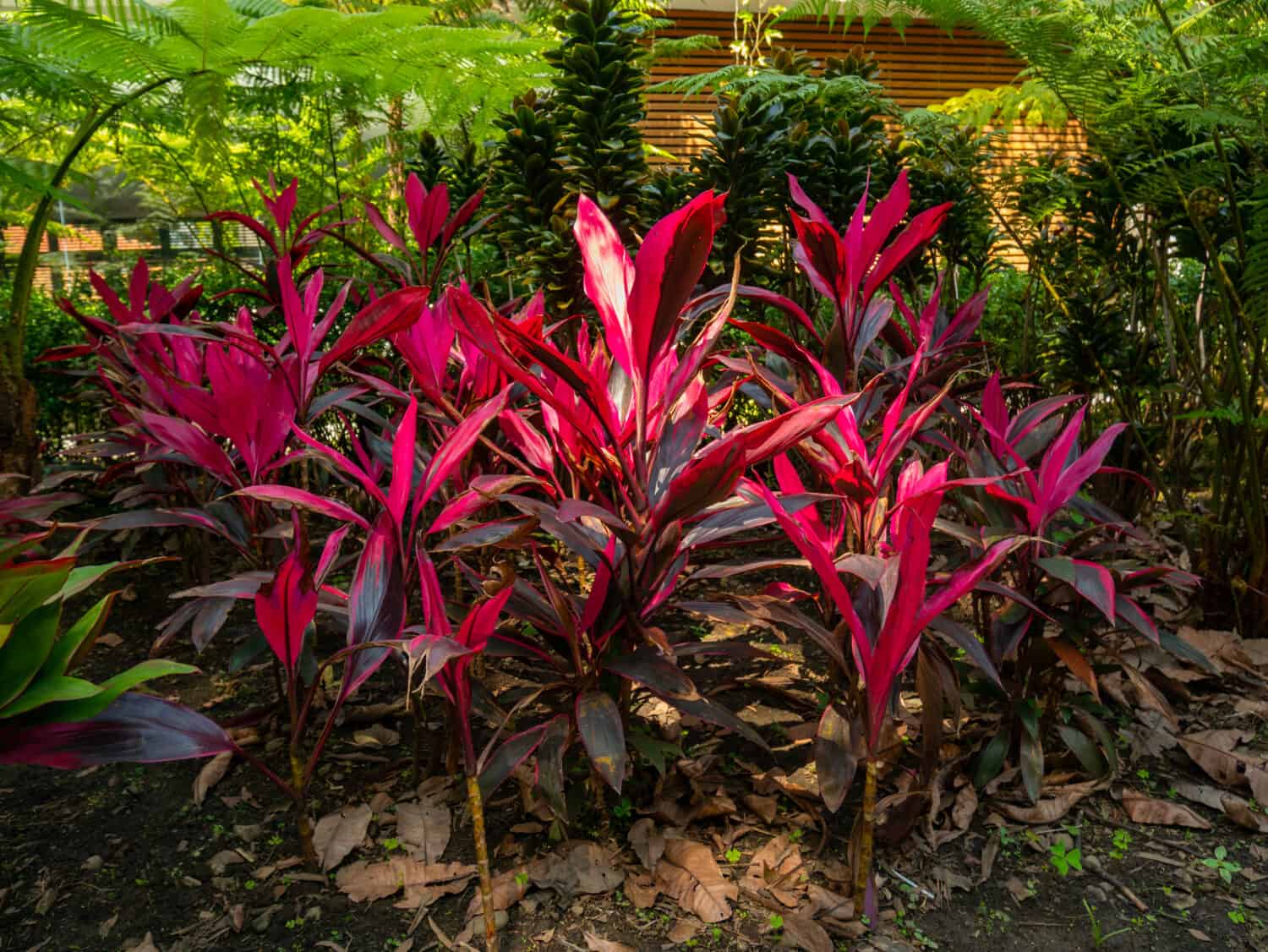
Hawaiian ti leaves were historically used to wrap food.
©Alexandre Laprise/Shutterstock.com
12. Kentia Palm (Howea forsteriana)
The Kentia palm’s timeless elegance and adaptability to varying light conditions have made it a cherished choice among plant enthusiasts. Its presence adds a touch of tropical paradise to your interior decor, creating a tranquil and sophisticated atmosphere. It produces slender, arching fronds that create a delicate, airy appearance.
Furthermore, its long, slender stems produce pinnate leaves that can reach up to 12 feet indoors, making it one of the tallest palm species suitable for indoor cultivation. The leaves are typically dark green and gracefully arch downward, creating a cascading effect that adds a sense of tranquility to your living space.
Originating from Lord Howe Island in the South Pacific, this palm species is low-maintenance with a timeless charm. It thrives in low to bright, indirect sunlight. They can tolerate lower light conditions, making them ideal for homes or offices with limited natural light. However, they are sensitive to cold drafts and temperature fluctuations, so keep them away from open vents.
Additionally, keep the soil evenly moist but not waterlogged. Kentia palms adapt to a range of humidity levels but appreciate occasional misting. Trim any yellowing or damaged fronds to maintain the plant’s appearance.
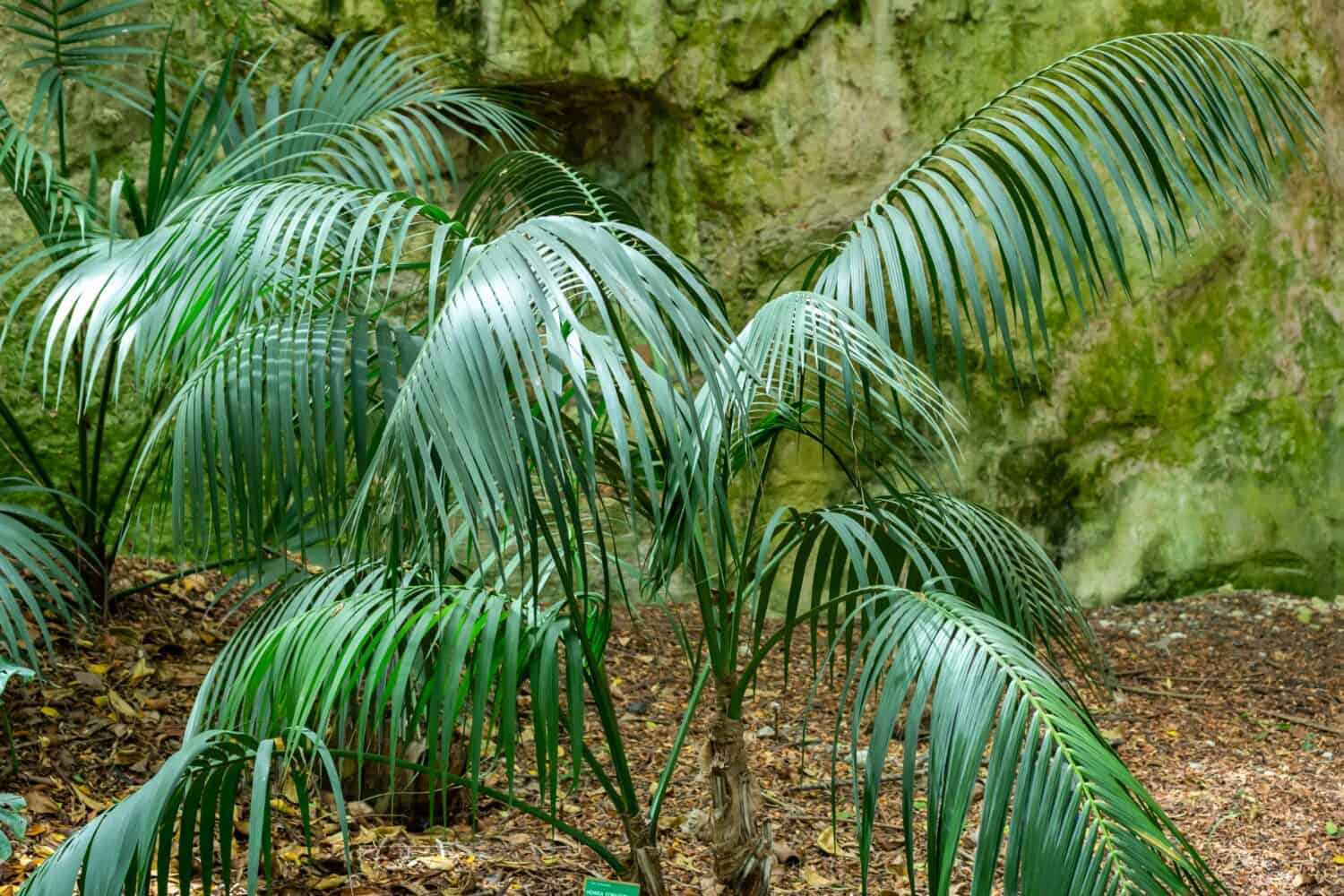
Kentia palm is also known as thatch palm or court palm.
©Daniele RUSSO/Shutterstock.com
13. Lady Fern (Athyrium filix-femina)
The lady fern is a delicate and charming indoor plant celebrated for its finely divided fronds and elegant appearance. Native to temperate regions across the Northern Hemisphere, this fern variety adapts to various indoor conditions. Its finely divided fronds create a feathery and airy canopy. Additionally, its fronds are typically bright green and have a delicate appearance, giving the plant its elegant charm.
Lady ferns grow up to 6 feet tall and are low-maintenance. They love moist soil but ensure they have good drainage. They do not tolerate temperature fluctuations. However, they prefer a moderate to cool environment, around 60 to 75 degrees Fahrenheit. Lastly, they grow best in indirect light near windows to avoid scorched fronds.
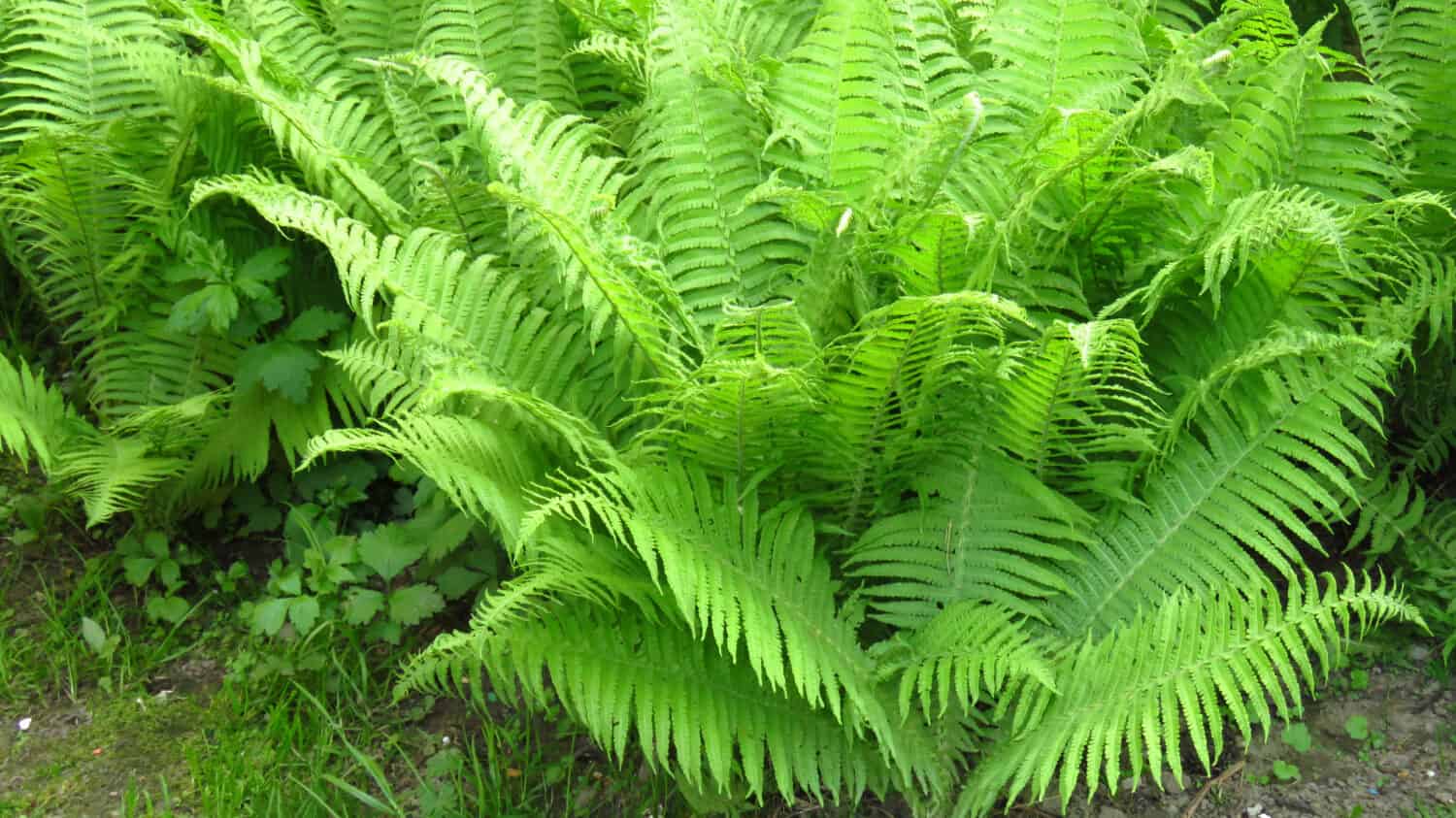
Lady ferns grow throughout the North American woodlands.
©Przemyslaw Muszynski/Shutterstock.com
14. Madagascar Dragon Tree (Dracaena marginata)
Dramatic foliage and easygoing care requirements make the Madagascar dragon tree a top choice for tall indoor plants. Its architectural presence brightens up any room and brings a sense of natural beauty indoors. The Madagascar dragon tree produces striking, spiky leaves and graceful stems.
Its long, slender, red-edged green leaves can grow up to 3 feet in length, creating a distinctive and visually appealing look. When cultivated indoors, it reaches heights of 6 feet, making it a perfect choice for adding vertical interest to your living spaces. As it matures, it also develops multiple stems, adding to its decorative appeal.
Specimens originated on the island of Madagascar in the Indian Ocean, and the low-maintenance species thrive in indirect sunlight but can tolerate lower light conditions. Place them near a window with filtered light for optimal growth and protect them from the cold.
Water sparingly and ensure the pot has proper drainage to prevent root rot. They adapt to various humidity levels and only require trimming. Cut back yellowing or damaged leaves to maintain their appearance.
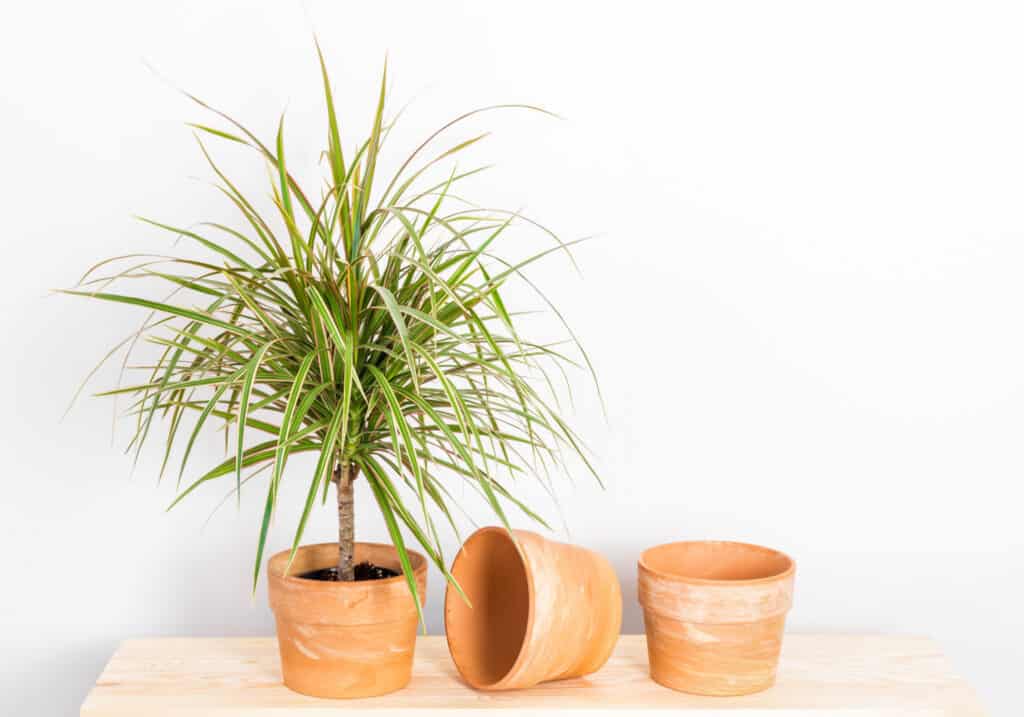
Dragon trees are slow-growing and low-maintenance.
©Studio Light and Shade/Shutterstock.com
15. Money Tree (Pachira aquatica)
The Money tree’s association with prosperity and its unique appearance have made it a sought-after houseplant. Whether you believe in its symbolic power or simply appreciate its elegance, this plant can bring both beauty and positive energy into your indoor space. It is instantly recognizable for its iconic braided trunk, which is often a feature of younger plants.
Additionally, Its glossy, palmate leaves are bright green and radiate from the top of its trunk. When cultivated indoors, money trees reach heights of 6 to 8 feet. As the plant matures, it may produce fragrant, umbrella-like clusters of white or cream-colored flowers, which can develop into small, edible nuts.
The money tree originates from the wetlands of Central and South America. Caring for this tropical tree is relatively straightforward, making it suitable for both novice and experienced plant enthusiasts. It thrives in indirect sunlight. Place them near a window with filtered light, but avoid direct sunlight that can scorch their leaves.
Protect specimens from drafts and cold and allow the top inch or two of soil to dry out between waterings. Water thoroughly, but avoid letting the plant sit in standing water to avoid root rot. Money trees are adaptable, but they prefer higher humidity.
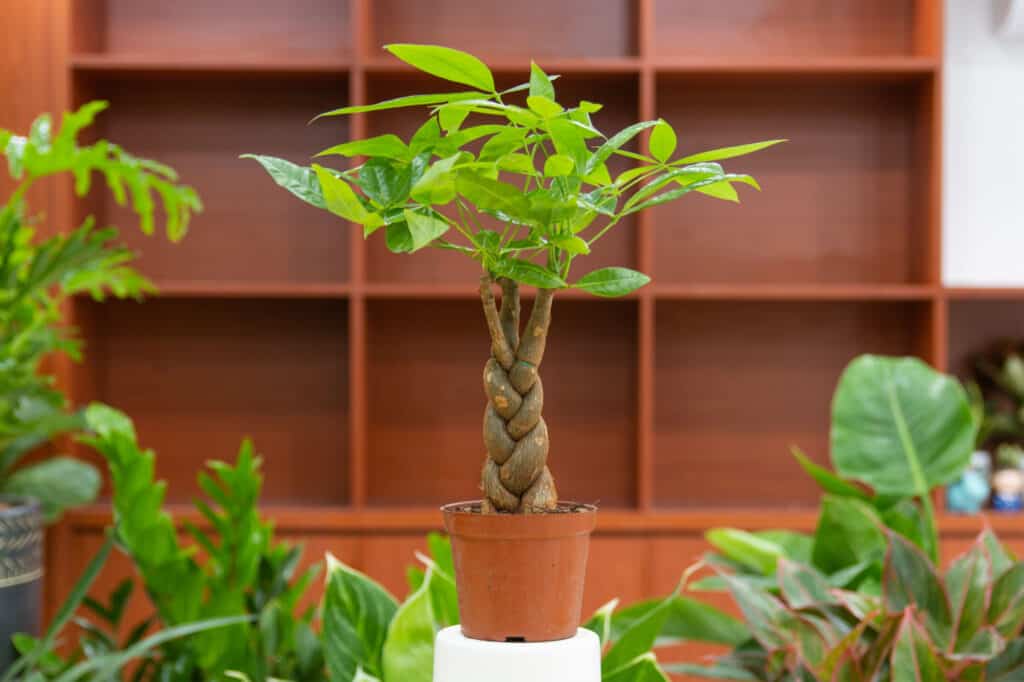
Money trees grow up to 30 feet outdoors but top out around 7 feet inside.
©Mid Tran Designer/Shutterstock.com
16. Natal Mahogany (Trichilia emetica)
Another tropical variety, the Natal mahogany plant has a unique growth habit. It is native to southern Africa and is an evergreen tree with an elegant appearance and air-purifying qualities. It produces large, pinnate leaves that are typically dark green and glossy, creating an impressive canopy. The leaves also have a unique growth habit, appearing in a spiral pattern along the stems, which adds to the plant’s visual appeal.
The Natal mahogany grows between 6 to 10 feet indoors. However, it is high-maintenance and requires high humidity levels. Regular misting or using a humidity tray can help maintain optimal moisture around the plant. It thrives in indirect sunlight and does not tolerate direct light, which can scorch its leaves.
Specimens also grow best in moist but never waterlogged soil and also require regular trimming to remove yellowing or overgrown leaves and maintain their appearance.

Find Natal mahogany growing in rainforests in the wild.
©Purves, M., CC BY-SA 3.0 , via Wikimedia Commons – Original / License
17. Norfolk Island Pine (Araucaria heterophylla)
The Norfolk Island pine resembles a miniature Christmas tree, and its ease of care makes it a popular choice for holiday decor and year-round enjoyment. It is a charming and distinctive evergreen tree that is native to Norfolk Island in the South Pacific. It is characterized by its tiered, horizontal branches that radiate from its center trunk, creating a perfectly symmetrical and layered look.
Its needle-like leaves are typically deep green and can give the plant an overall conical shape. When cultivated indoors, Norfolk Island pines can reach heights of 6 to 8 feet or even taller, adding vertical interest to your living spaces. Furthermore, caring for a Norfolk Island pine is relatively straightforward.
These trees thrive in bright, indirect sunlight. Place them near a window with filtered light, ensuring they receive several hours of sunlight. They love warm environments and moist soil, especially during the growing season. Norfolk Island pines also appreciate higher humidity levels and regular misting,
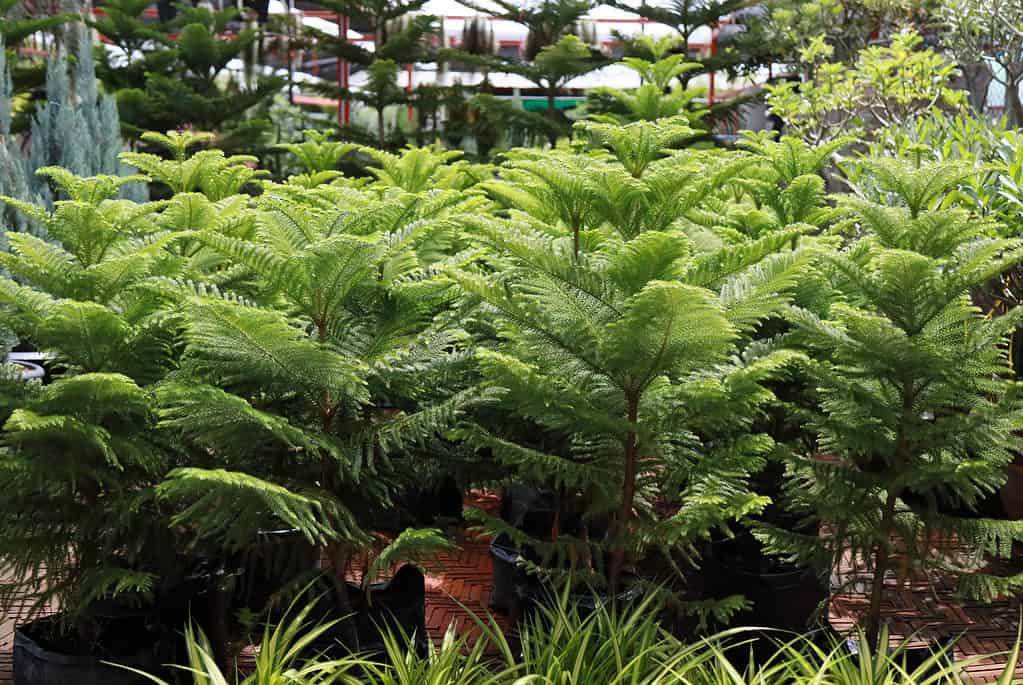
The Norfolk Island pine grows up to 200 feet in the wild.
©ZANTACUZ/Shutterstock.com
18. Philodendron Birkin (Philodendron ‘Birkin’)
A hybrid variety you won’t find in the wild, Birkin is a member of the Philodendron genus. Birkin’s striking variegation elevates indoor plant collections with a touch of contemporary elegance. It produces glossy, heart-shaped leaves that feature distinct creamy or white stripes. These striking variegations run along the length of each leaf, creating a visually appealing pattern that sets it apart from other Philodendron varieties.
When grown indoors, Birkin typically grows slowly, up to 4 feet, making it a manageable and decorative addition to indoor spaces. The low-maintenance plant loves bright, indirect sunlight, but avoid exposing it to direct sunlight, which can scorch its leaves. Additionally, be sure to protect it from temperature fluctuations.
Keep Birkin’s soil consistently moist but not waterlogged, and adjust your watering frequency based on your indoor humidity and lighting conditions. Lastly, trim any yellowing or damaged leaves to maintain your plant’s appearance and promote new growth.
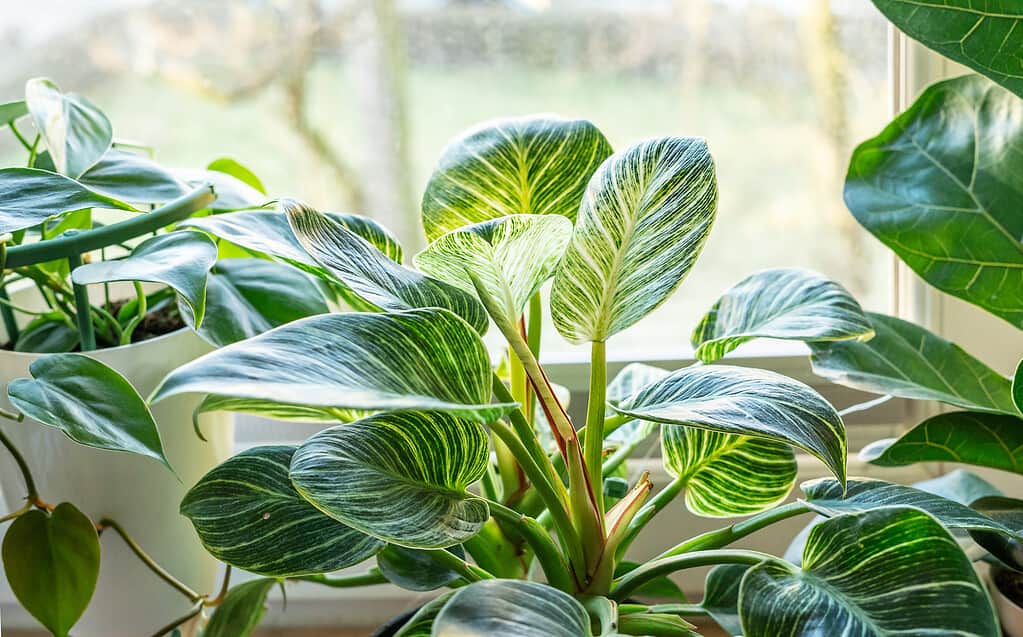
Birkin entered the world as a mutation of another popular
Philodendronvariety.
©Nataliia Tymofieieva/ via Getty Images
19. Pothos (Epipremnum aureum)
Bring a touch of the jungle into your home with this cascading vine. The pothos trailing vine can grow to impressive lengths, up to 10 feet. They are perfect for hanging baskets or as trailing specimens on high shelves and long tables. The heart-shaped leaves are typically a rich green color, but variegated varieties with white or yellow streaks are also popular.
Pothos can thrive in a variety of conditions and grow rapidly. Originating from the Solomon Islands in the South Pacific, this versatile plant is low-maintenance and thrives in a range of light conditions, from low to bright. They also adapt to low-light environments, making them versatile for various spaces. Additionally, they are relatively tolerant of temperature fluctuations.
Water pothos thoroughly, and be cautious not to overwater, as they are susceptible to root rot. They are adaptable to different humidity levels but appreciate occasional misting. Trim or pinch back the vines to maintain your desired length and fullness of the plant. Regular pruning also encourages bushier growth.
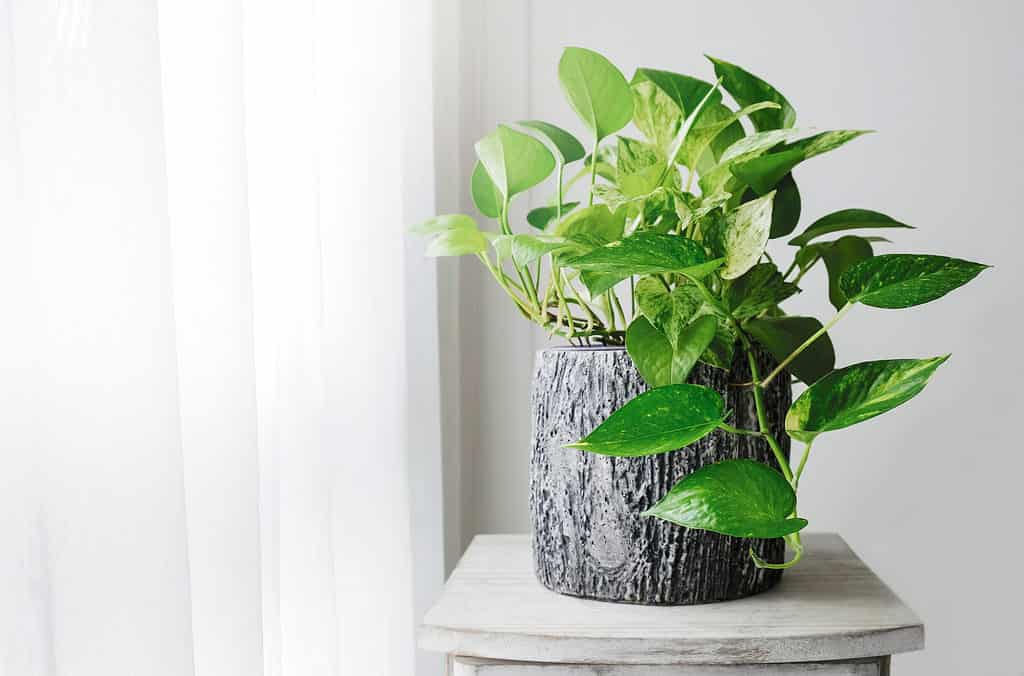
Pothos is so low-maintenance it is nicknamed devil’s ivy because it is hard to kill.
©ArtBackground/Shutterstock.com
20. Rubber Plant (Ficus elastica)
Another member of the Ficus genus, the rubber plant is an elegant and hardy choice for enhancing your indoor space. The robust plant produces large, thick, and shiny leaves that can vary in shape from oval to lanceolate. These leaves are typically dark green, although there are variegated varieties with creamy stripes or marbling.
When cultivated indoors, rubber plants grow between 6 to 10 feet or more. Their upright and statuesque growth habit makes them a standout addition to any interior decor. Like most houseplants, it grows best in bright, indirect sunlight near a window with filtered light. However, avoid direct sun exposure, which can scorch the leaves.
The rubber plant loves consistently moist soil, especially during its growing season. It also appreciates higher humidity levels. Trim yellowing or overgrown leaves to maintain the plant’s appearance and shape.
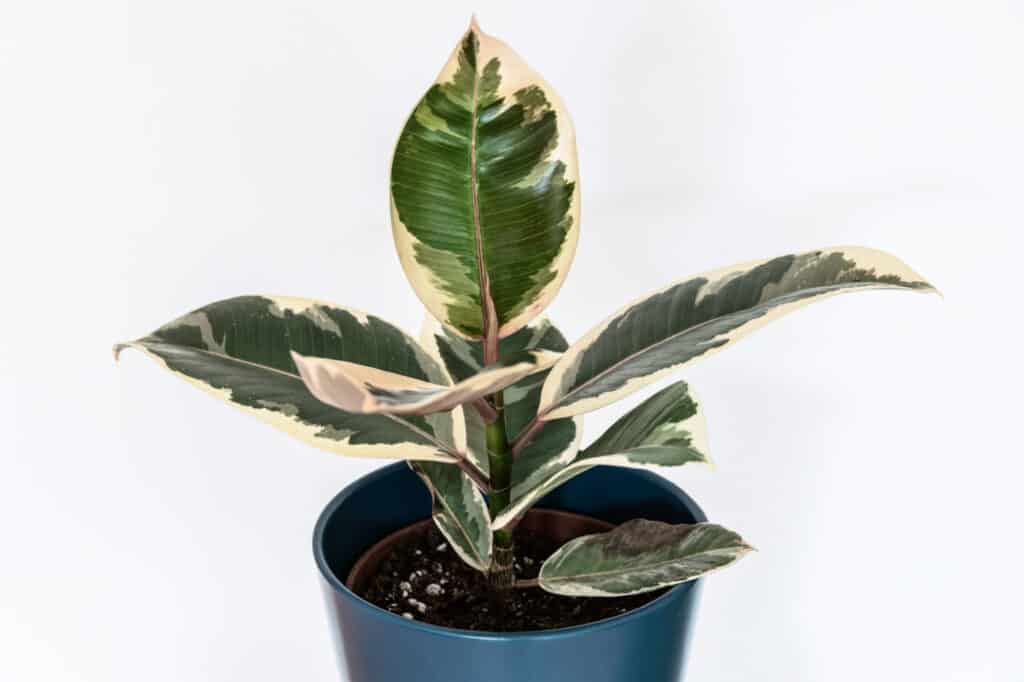
Rubber plants live 15 years or more indoors.
©Maritxu/Shutterstock.com
21. Snake Plant (Sansevieria trifasciata)
The snake plant purifies your space while introducing lush greenery that requires minimal effort. It has a sleek and modern appearance and thrives in diverse conditions. This versatile plant is native to West Africa and appreciates warmer indoor conditions.
Specimens produce long, upright, and lance-shaped leaves that are typically dark green and marked with distinctive, mottled patterns of light green or yellow. The leaves grow to varying heights, with mature specimens reaching around 4 feet tall.
It is an ideal choice for beginners and thrives in a wide range of light conditions, from low to bright sunlight. They are highly adaptable and can also tolerate lower light levels. They prefer indoor temperatures between 70 to 90 degrees Fahrenheit. However, they are relatively tolerant of temperature fluctuations.
Water specimens sparingly. Snake plants are susceptible to root rot if overwatered. They are also adaptable to various humidity levels and do not require additional misting or humidity adjustments.
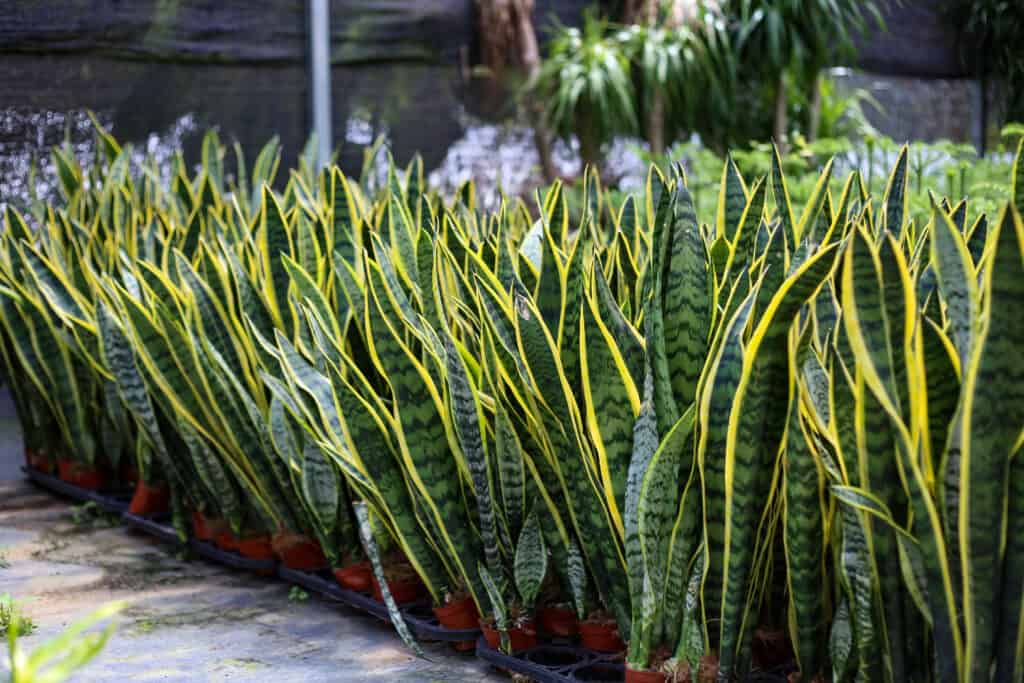
Snake plant has excellent air-purifying qualities. They release oxygen every evening.
©iStock.com/Joimi Joh Abi
22. Swiss Cheese Plant (Monstera deliciosa)
Gardeners everywhere recognize Monstera plants for their iconic island vibes and large foliage. The Swiss cheese plant is native to the rainforests of Central America and produces large, glossy, and deeply lobed leaves, which bear a resemblance to Swiss cheese due to their distinctive perforations. Its leaves can grow up to 2 feet in length, creating an impressive tropical canopy.
When cultivated indoors, the Swiss cheese plant reaches heights of 6 to 10 feet, making it a captivating focal point. As the plant matures, it may produce unique and edible fruits. It is a high-maintenance plant that grows best in bright, indirect sunlight near a window with filtered light. However, direct sun exposure can scorch its leaves.
Swiss cheese plants thrive in higher humidity levels and love regular misting. Additionally, trim yellowing or overgrown leaves to maintain the plant’s appearance and encourage new growth.
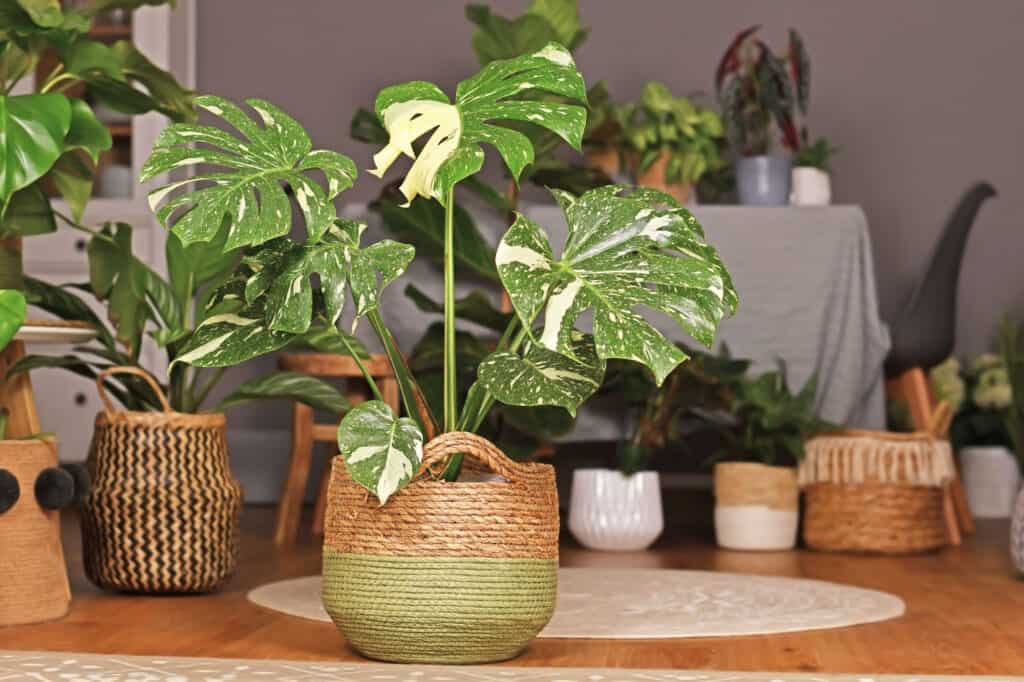
Monstera houseplants grow up to 10 feet tall.
©Firn/Shutterstock.com
23. Umbrella Tree (Schefflera)
The umbrella tree’s graceful canopy and sculptural presence make it a sought-after choice for those looking to infuse their indoor spaces with natural beauty. This floor plant is native to tropical regions and is incredibly low-maintenance. It produces distinct compound leaves, which resemble the spokes of an umbrella. Its leaves are typically glossy green and composed of multiple leaflets.
The umbrella tree grows up to 8 feet indoors, creating a graceful and towering presence. Their branches radiate outward in a symmetrical fashion, giving the plant a well-balanced and sculptural look. Like many plants, direct sunlight can scorch their leaves, and they thrive in indirect and filtered light.
Specimens love moist soil during the spring and summer growing seasons. However, allow the top inch of soil to dry out between waterings. Umbrella trees also adapt to various humidity levels but appreciate occasional misting. Finally, they appreciate the trimming of yellowing or overgrown leaves to maintain their appearance and shape.

The umbrella tree is fast-growing, reaching up to 10 feet indoors.
©Wong Gunkid/Shutterstock.com
24. Weeping Fig (Ficus benjamina)
This member of the Ficus genus, the weeping fig, is an iconic and elegant indoor tree celebrated for its graceful, weeping branches and glossy, evergreen leaves. Native to Southeast Asia and Australia, this beloved plant has a tall stature and lush canopy. It produces dense, weeping branches adorned with small, elliptical leaves. Additionally, its leaves are rich, dark green and glossy.
The weeping fig grows up to 10 feet tall with cascading branches. It grows well in indirect sunlight but is susceptible to leaf burn in direct light. It also does not tolerate temperature fluctuations and prefers moist but never waterlogged soil. They also love high humidity levels and consistent misting.
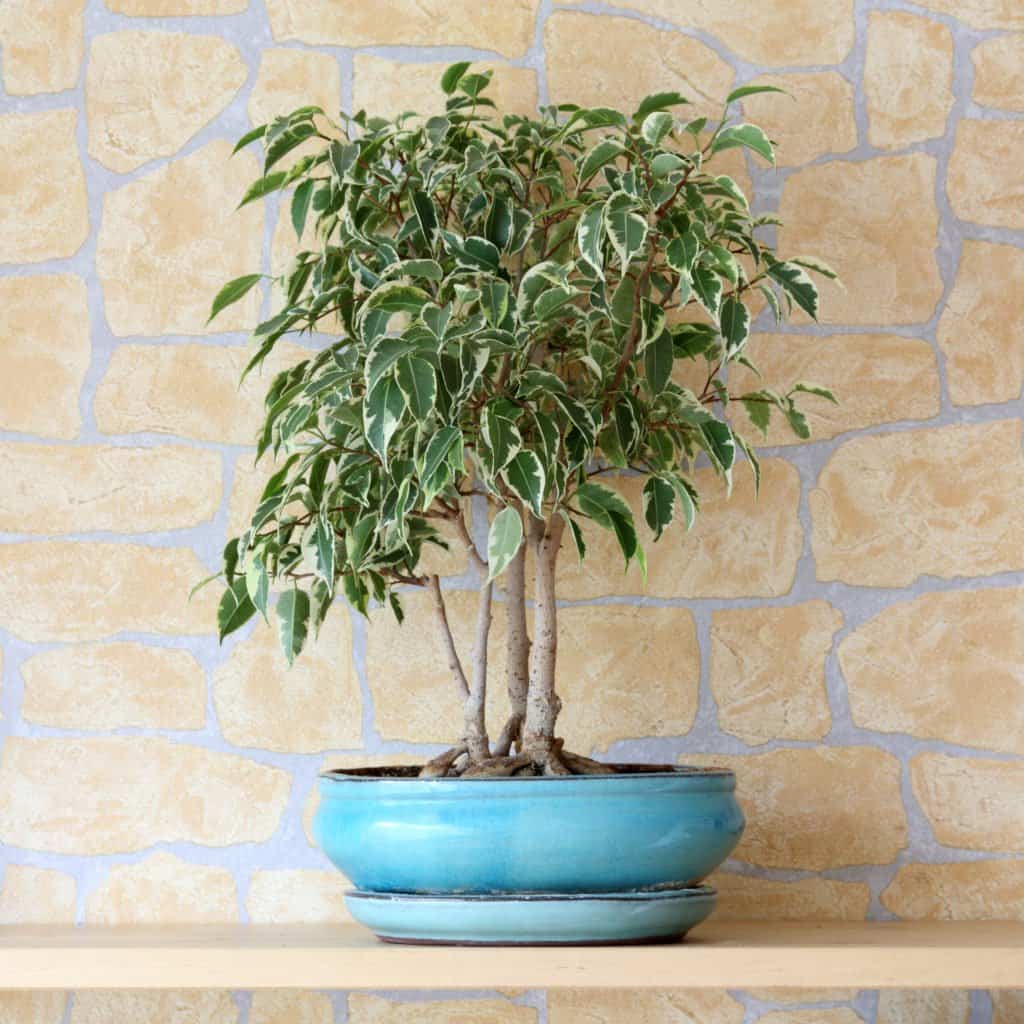
Weeping figs are slow-growing houseplants.
©loflo69/Shutterstock.com
25. Yucca Plant (Yucca elephantipes)
Thriving in desert regions and native to Central America and the Caribbean, the yucca plant is resilient and striking. Experts characterize the yucca plant by its long, lance-shaped leaves that grow in a rosette formation, creating a dramatic and architectural presence. Its leaves are typically dark green and have a pointed tip, which adds to the plant’s desert-inspired aesthetic.
Yucca plants add vertical accents to indoor spaces, growing up to 8 feet tall. They are hardy and low-maintenance. Specimens grow best near windows with indirect light and are very sensitive to cold drafts. This desert-loving variety does not require much water, so water sparingly. It is also incredibly drought-tolerant and may rot if overwatered. Yucca plants adapt to low humidity levels and do not require misting.
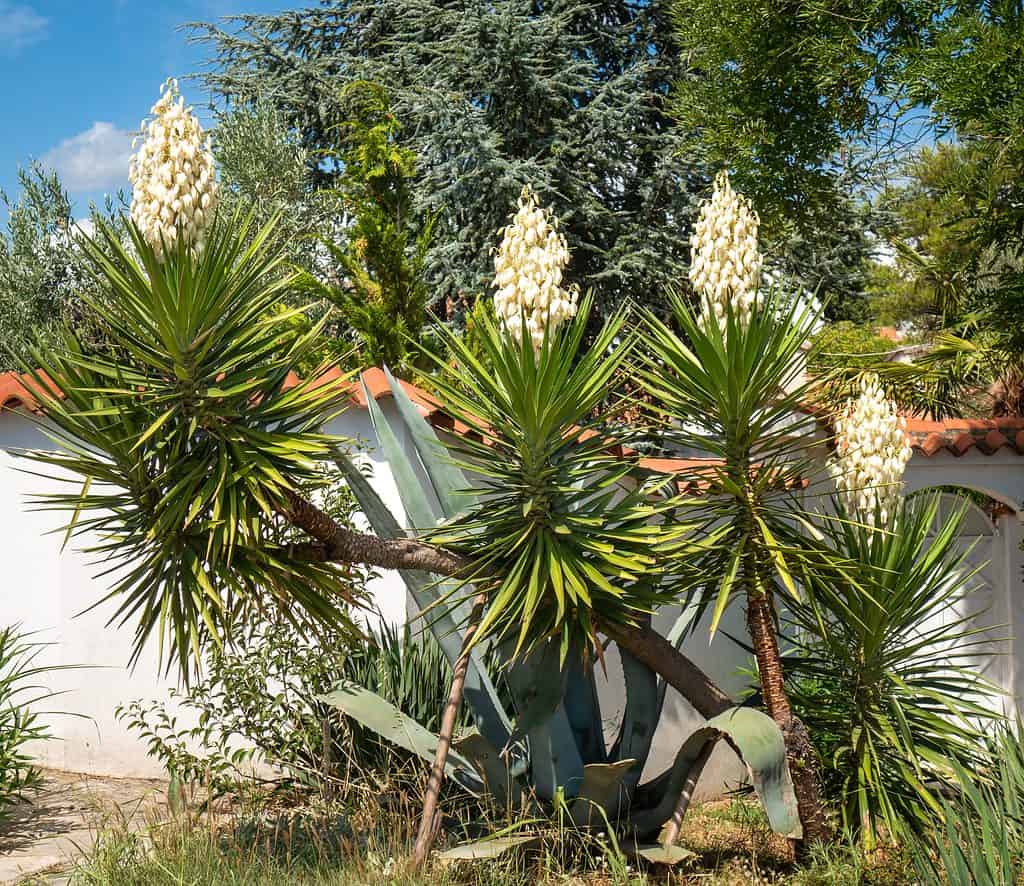
Yucca plants produce edible fruits.
©Peter Klampfer/Shutterstock.com
Summary: 25 Tall Indoor Plants
| Number | Common Name | Mature Indoor Height |
|---|---|---|
| 1 | African Milk Tree | 8 feet |
| 2 | Areca Palm | 7 feet |
| 3 | Australian Tree Fern | 10 feet |
| 4 | Bird of Paradise | 6 feet |
| 5 | Cat Palm | 6 feet |
| 6 | Corn Plant | 6 feet |
| 7 | Croton | 6 feet |
| 8 | False Banana Tree | 10 feet |
| 9 | Fiddle Leaf Fig | 10 feet |
| 10 | Fishtail Palm | 10 feet |
| 11 | Hawaiian Ti | 6 feet |
| 12 | Kentia Palm | 12 feet |
| 13 | Lady Fern | 6 feet |
| 14 | Madagascar Dragon Tree | 6 feet |
| 15 | Money Tree | 8 feet |
| 16 | Natal Mahogany | 10 feet |
| 17 | Norfolk Island Pine | 8 feet |
| 18 | Philodendron Birkin | 4 feet |
| 19 | Pothos | 10 feet |
| 20 | Rubber Plant | 10 feet |
| 21 | Snake Plant | 4 feet |
| 22 | Swiss Cheese Plant | 10 feet |
| 23 | Umbrella Tree | 8 feet |
| 24 | Weeping Fig | 10 feet |
| 25 | Yucca Plant | 8 feet |
Thank you for reading! Have some feedback for us? Contact the AZ Animals editorial team.








